Story at a glance:
- Regenerative architecture aims to create buildings with a net positive impact on the environment.
- There are a few key principles governing regenerative architecture, including whole systems thinking, landscape integration, resource replenishing, biodiversity, and equitable collaboration.
For the last 20 years or so sustainable design has skyrocketed in popularity. But many architects and designers are saying it’s not enough to simply do “less bad” when it comes to the environmental impact of built structures.
That’s why, in recent years, regenerative architecture has seen an uptick within the green design community. Instead of just limiting the use of resources, regenerative architecture projects seek to replenish resources and rejuvenate the landscape in which they are embedded.
Let’s take a look at the basics of regenerative architecture, its importance, the core principles that define it, and a few inspiring real world examples of regenerative design in action.
What is Regenerative Architecture?

The Wolf Ridge Environmental Learning Center Margaret A. Cargill Lodge embodies regenerative architecture in a variety of ways and fosters a strong connection with nature. Photo by Rick Peters
From an ecological perspective, “regenerative” refers to the ability of an ecosystem—that is, the land itself and all of its living and non-living inhabitants—to recover and replenish from ecological harm.
Regenerative design in architecture describes a specific methodology or philosophy that views the built environment as an extension of the natural environment and seeks to construct buildings with a positive impact on their respective ecological communities. Rather than simply reduce their consumption of energy or resources, regenerative buildings actively give back more than they take by mimicking the restorative biological systems found in nature.
Regenerative vs Sustainable Architecture
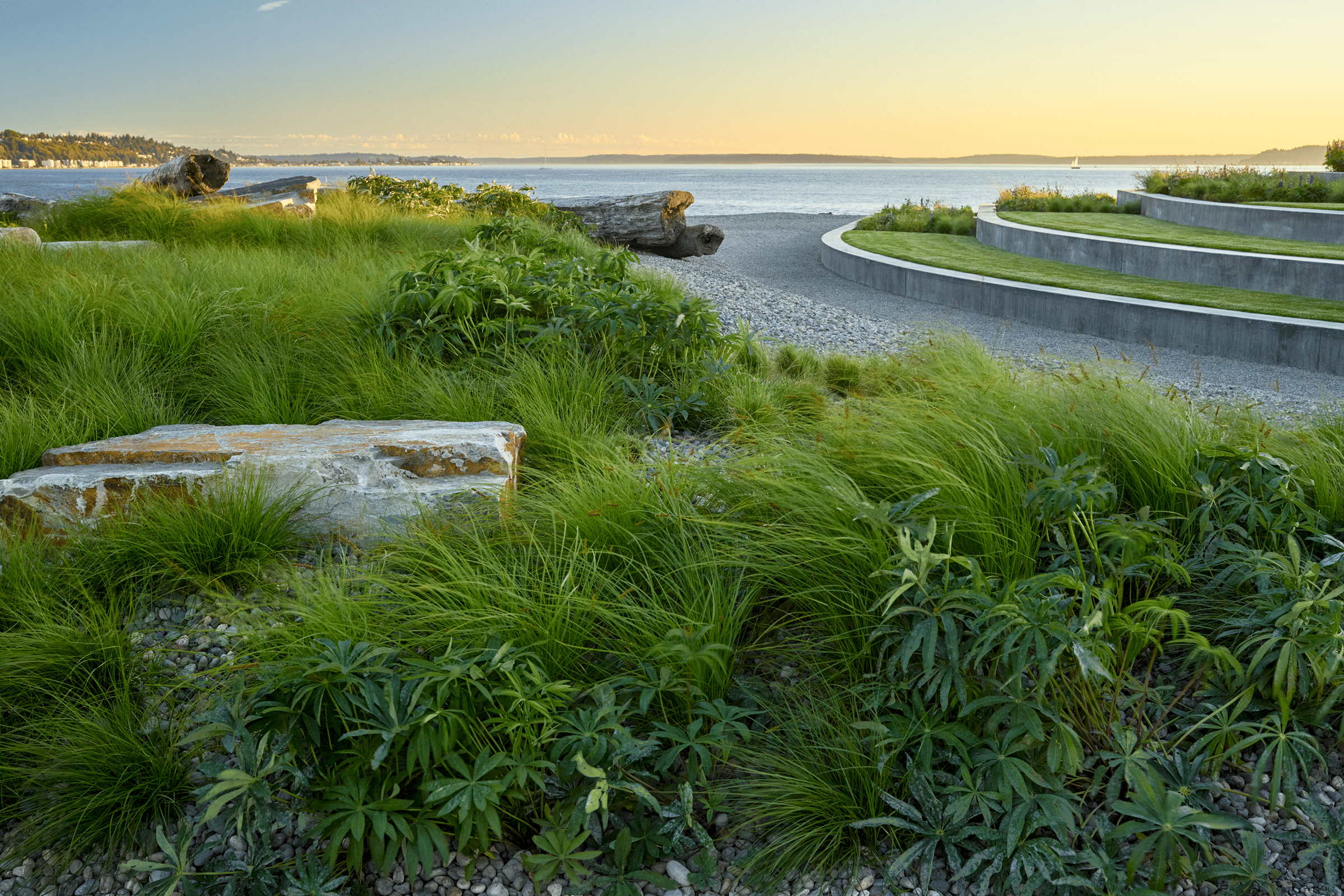
Landscaping with native plants is an integral component of both sustainable and regenerative architecture. Photo by Marion Brenner
At this point, you may be thinking that regenerative architecture sounds a lot like sustainable architecture—and while they do share some similarities, regenerative architecture differs in a few important ways.
Regenerative Architecture
As previously mentioned regenerative architecture is the practice of designing buildings as an extension of the existing ecological community, or buildings whose presence functions as an integral component of the immediate ecosystem they are embedded in.
Rather than simply reduce the project’s environmental impact or use of resources, regenerative structures are designed to have a net-positive effect. In short, they are actually meant to help restore resources and aid in the reversal of existing ecological damage. In this regard regenerative architecture is much more holistic than sustainable architecture.
Sustainable Architecture
Sustainable architecture, on the other hand, focuses primarily on limiting a building’s use and consumption of resources—both renewable and nonrenewable—as much as possible. In most cases sustainable design only goes so far as to create buildings with a net-zero impact on the natural world, especially with regard to a project’s cumulative carbon emissions.
Ultimately it may be useful to view sustainable design as a facet of regenerative architecture—one that offers useful strategies and technologies to reduce energy consumption and resource extraction; on its own, however, sustainable architecture isn’t enough.
Why is Regenerative Architecture Important?
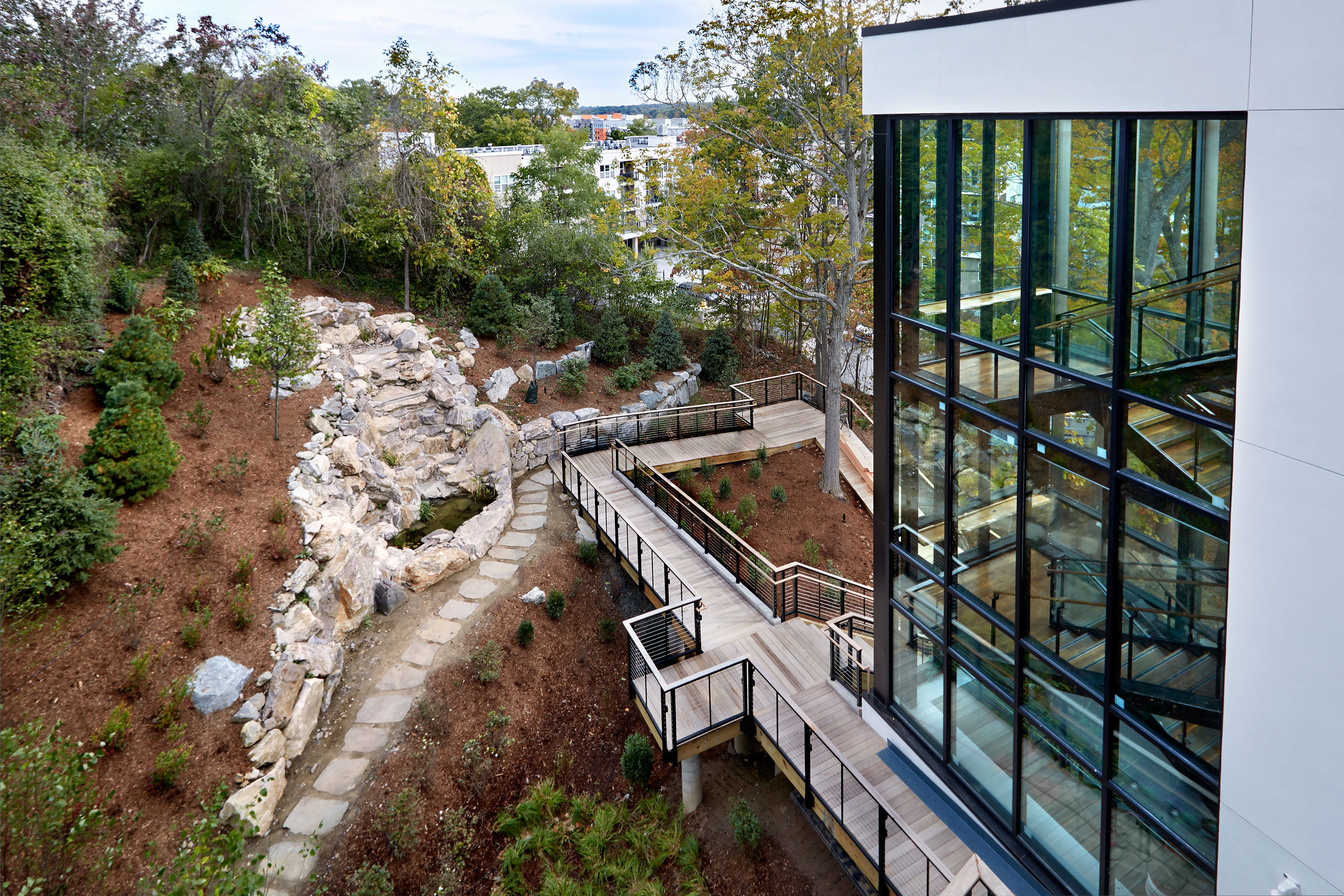
In order to preserve as much of the existing landscape as possible, the HMTX World Headquarters sits on upraised columns. Photo courtesy of HMTX Industries
In the fundamental sense regenerative architecture is important in that it is necessary if humanity hopes to stave off—and eventually reverse—the worst effects of anthropogenic climate change.
As it stands the built environment is responsible for producing roughly 40% of the world’s carbon emissions, whereas the construction industry extracts more than 30% of Earth’s natural resources.
Regenerative architecture represents the best method for reducing those figures, as it seeks to design zero-carbon buildings that actively replenish the resources used during their construction and operation. What’s more, when it is combined with climate responsive design, regenerative architecture represents the best method for designing buildings that can adapt to the changing climatic conditions we currently face.
Other benefits of regenerative architecture include, but are not limited to, the following:
- Improved mental and physical health
- Greater connection to the natural world
- Reduced water, air, and soil pollution
- Species conservation
- Lower operating costs
Core Principles of Regenerative Architecture
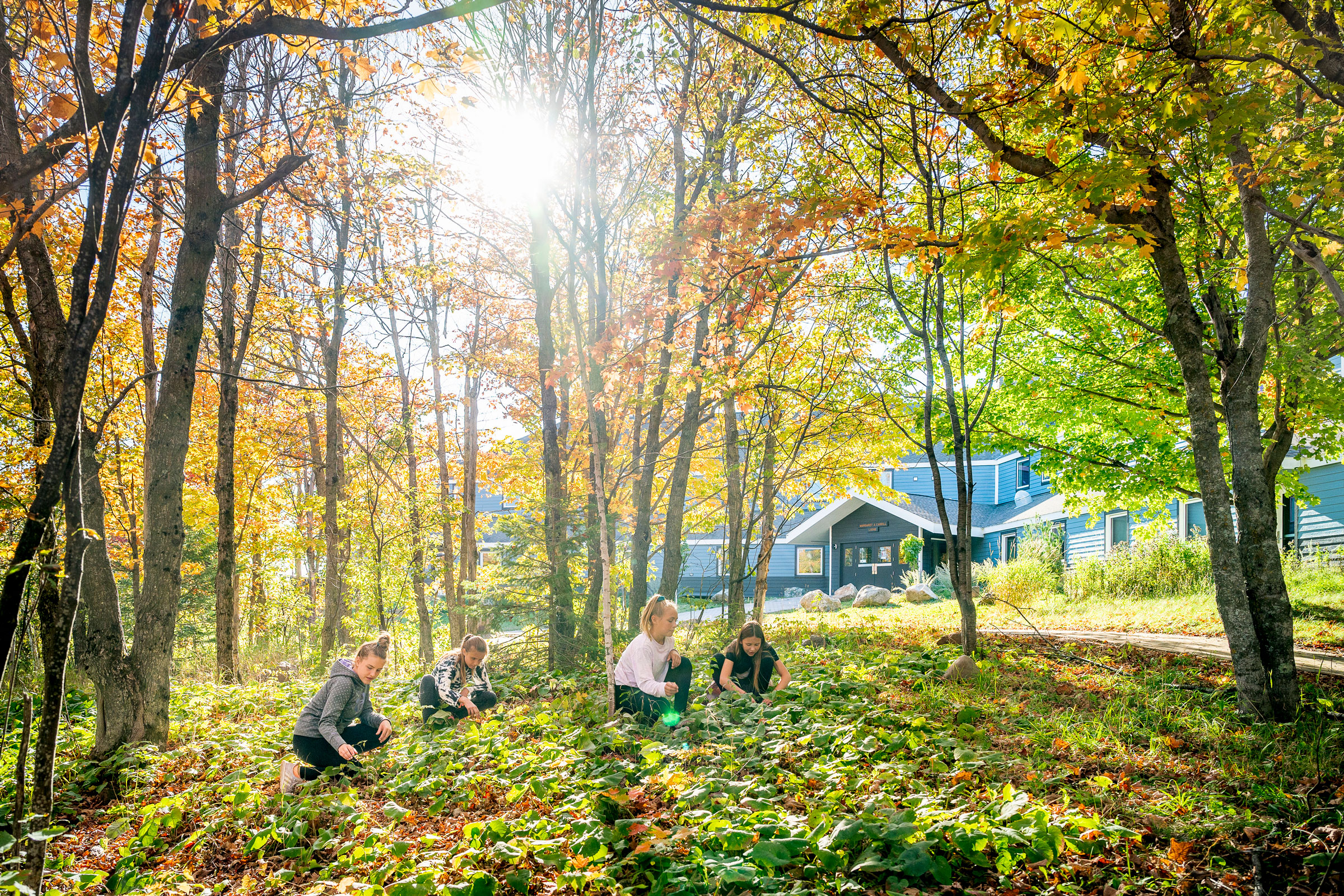
The Wolf Ridge Environmental Learning Center Margaret A. Cargill Lodge, designed by HGA, is the first renovation project to achieve Living Building Challenge Certification. Photo by Chad Holder
Since its inception there have been a variety of proposed models outlining the basic foundational aspects of regenerative architecture as a unique field of study. And while the details of each model vary, there are a few core principles repeated throughout all of them that help establish a general guiding framework.
Whole Systems Thinking & Interdependence
One of the most integral principles governing regenerative architecture is the notion of whole systems thinking—or the practice of considering all factors and players that are present at—or interact with—the proposed project site. In many ways this parallels the architectural practice of conducting a thorough site analysis at the beginning of the design process.
Soil composition, seasonality, climate, annual rainfall, migration patterns, geographic features, groundwater levels, prevailing winds, indigenous plant and animal species, and more are all important factors to consider when designing a regenerative structure.
By approaching a proposed building site as part of a larger system, it becomes easier to envision the completed project as an integral member of the ecological community, rather than a separate entity imposed upon a landscape.
Ultimately this leads to healthy interdependence between all parts and players in the system. Each part of the system serves multiple functions and is designed to mutually support all other parts, creating an interconnected network of mutually beneficial relationships.
Landscape Integration
Rather than viewing buildings as separate from the natural world, regenerative architecture conceptualizes the built environment as an extension of the local biological environment. As a result the finished building is fully integrated into the landscape itself and functions as an active component within the ecological community. In this way buildings are designed to co-evolve alongside existing flora and fauna, adapting as needed to changes in environmental conditions or needs.
This is achieved largely through the implementation of biomimetic design strategies, or those methodologies that replicate designs found in nature in order to passively improve a building’s performance. Such strategies may include on-site water purification, renewable energy production, carbon-capturing, building envelopes that help remove pollutants from the air, and so on.
Biodiversity
Historically the construction and occupation of the built environment has contributed significantly to habitat loss and the extinction or endangerment of countless plant, animal, and insect species.
Regenerative architecture functions in part as a means of correcting this harm by assisting and maintaining biodiversity. This is achieved through careful analysis of the site to determine which species currently live there, as well as which species used to inhabit the site in the recent past.
Depending on the location this may be realized in a variety of ways, such as the inclusion of green roofs and walls seeded with indigenous plant species or larger-scale permaculture gardens that produce sustenance for both humans and other organisms.
When considering biodiversity in regenerative architecture projects, it is always recommended to consult local Indigenous or First Nations peoples who have extensive knowledge of the land—after all, it is Indigenous peoples who currently steward approximately 80% of the world’s biodiversity.
Resource Replenishment
Just as regenerative architecture aims to rejuvenate biodiversity, it also seeks to replenish those resources that have historically been depleted or contaminated by the construction and occupation of the built environment.
This can be realized in a variety of ways, but typically takes the form of onsite renewable energy generation (be it solar, wind, geothermal, etc.) and storage, rainwater collection, wastewater treatment and reuse, composting, integrated gardening/permaculture, and so forth. If trees must be cut down to build the project, for example, a greater number of native tree species should be planted as recompense.
Community & Social Equity
In order for regenerative architecture to be successful, it must be collaborative and involve people from a wide range of backgrounds, including those from the immediate community. This helps ensure equitable development as opposed to the so-called “green gentrification” that often accompanies ecologically conscious building projects, as it integrates the values and needs of the existing community into the project and its future growth.
Collaboration between diverse entities also provides more opportunities for knowledge sharing—and seeing as no one firm or studio has all of the answers, the project will ultimately benefit from the varied perspectives and solutions they offer.
Examples of Regenerative Architecture
Now that we’ve a better understanding of regenerative architecture and the principles that define it, let’s take a look at a few examples of regenerative design in action.
Studio Ma’s Xero Studio
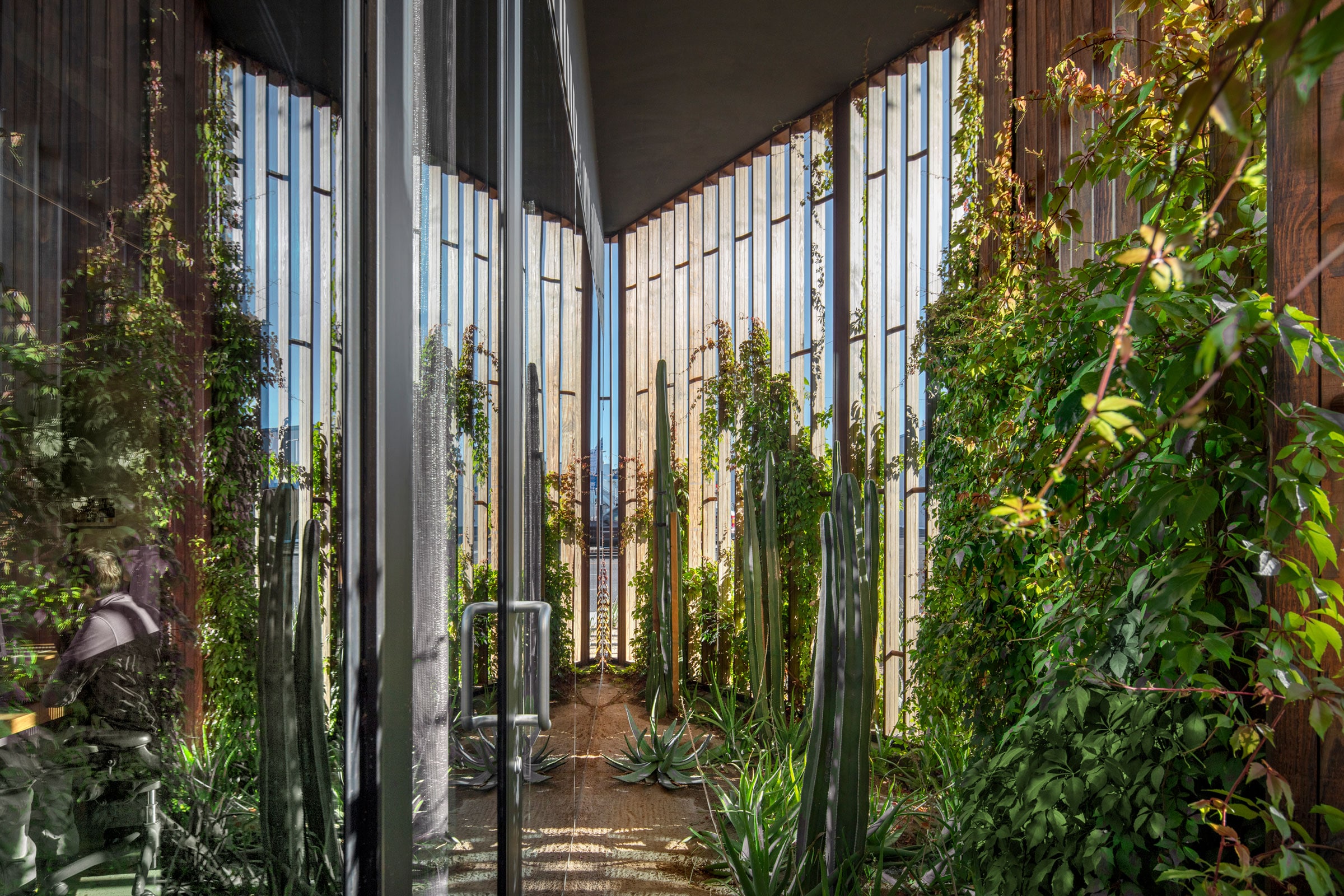
Studio Ma’s Xero Studio is a prime example of how regenerative architecture can thrive even in harsh desert climates. Photo by Bill Timmerman
In Phoenix, Studio Ma’s Xero Studio—designed by the firm of the same name—showcases how regenerative architecture can be implemented even in extreme environments.
Embedded in the Sonoran Desert, Xero Studio is clad in Kebony wood and uses architectural screening to reduce solar glare and heat gain, diminishing the need for mechanical air conditioning. Operable skylights also serve as daylighting strategies and ventilation points; when opened, they expel heat back outside, allowing the studio to passively cool itself for at least four months out of the year. Indigenous plant species further serve to cool the building by providing shade.
To achieve net-zero energy usage Studio Ma implemented photovoltaics that generate electricity from sunlight.
But Studio Ma wasn’t without roadblocks when designing their new headquarters. “Our goal is 100% regenerative architecture, but this restriction means we have had to become advocates with the city government to promote net-zero water policies, such as allowing for blackwater-to-potable systems,” Christopher Alt, architect with Studio Ma, previously told gb&d.
As is the case for many cities in the United States and throughout the world, Phoenix has regulations in place that prevent blackwater-to-potable water recycling systems. In lieu of these restrictions, Studio Ma has taken measures to improve onsite water efficiency and reduce wastewater production from the outset. Xeriscaped bioswales were implemented to effectively manage and filter stormwater runoff, aiding in the recharging of local groundwater reservoirs.
Wolf Ridge Environmental Learning Center
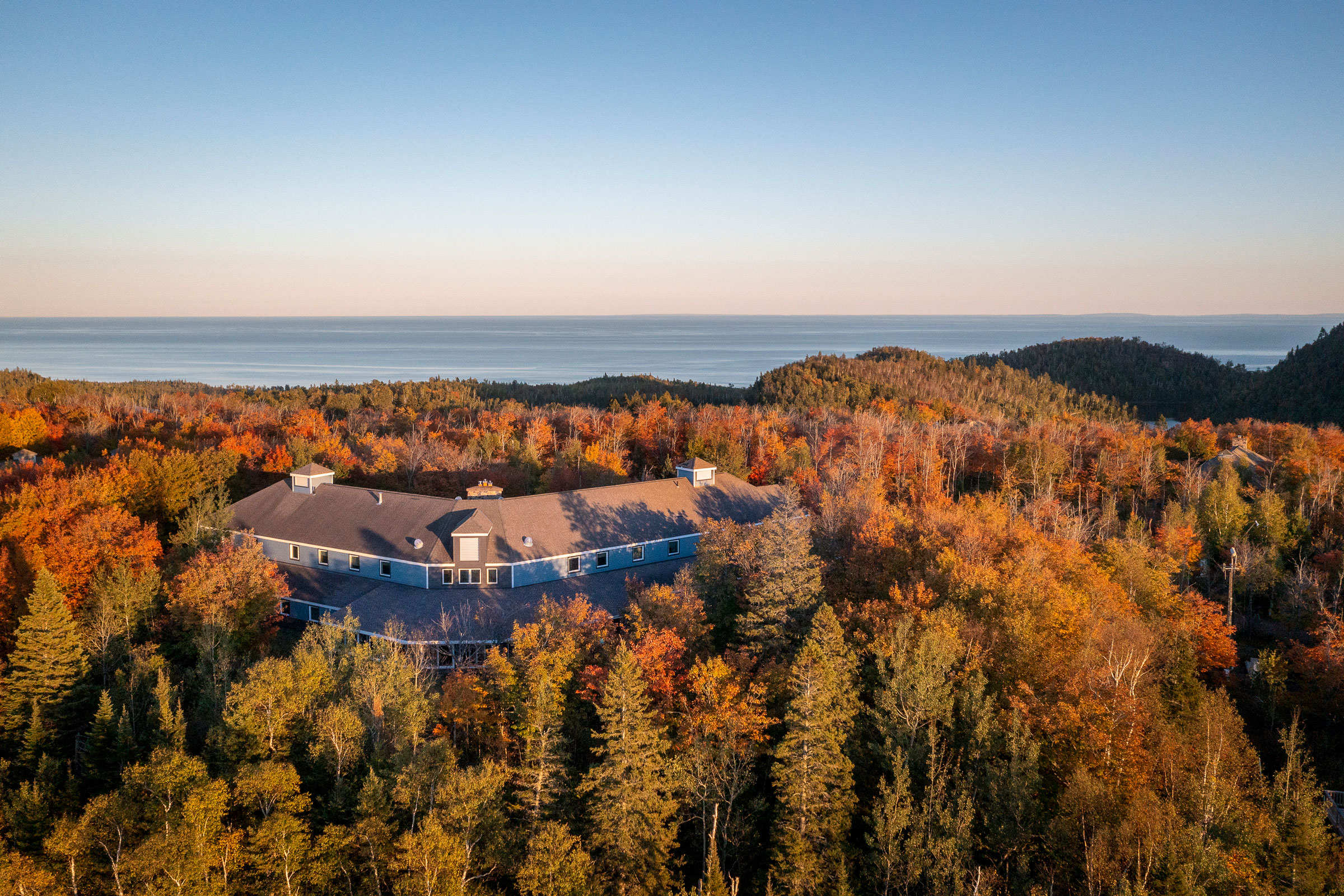
The MAC Lodge is nestled in the woods on a ridge that overlooks Lake Superior. It is the first renovation project in the world to become Living Building Challenge certified. Photo by Chad Holder
In the Northwoods of Minnesota, the Wolf Ridge Environmental Learning Center is exemplary in its use of regenerative design principles. Featuring a 10kW wind turbine, solar thermal domestic water heating, 18.5 kW photovoltaic array, and biomass space heating, the campus is a pioneer in renewable energy. An onsite organic farm provides approximately 20% of the center’s produce and composts all organic waste generated by the campus.
Of all of Wolf Ridge’s buildings, however, the Margaret A. Cargill (MAC) Lodge is the most impressive—and the first on-site structure to be Living Building Challenge certified.
Designed by HGA, the MAC Lodge—which is a renovation of the old center’s West Dorm—was built to achieve net-positive energy and water usage, generating or collecting more energy and water than it requires. All water is sourced from a well and does not require any sort of treatment—wastewater is collected, treated, and released on-site to refill underground water tables.
Passive cooling strategies reduce the need for mechanical climate control and intelligent room sensors automatically shut lights off when they aren’t needed. Daylighting strategies are implemented to the fullest extent and the lodge itself is surrounded by local flora, facilitating complete immersion with the surrounding environment.
HMTX World Headquarters

HMTX Industries’ new world headquarters is Connecticut’s greenest building and implements many aspects of regenerative design. Photo courtesy of HMTX Industries
Located in Norwalk, Connecticut and designed by McLennan Design, the HMTX World Headquarters is an inspiring example of regenerative architecture and is the first Living Building Challenge Petal Certified project in the state.
Situated on a dense, rocky outcrop, the HMTX World Headquarters is built from low-carbon materials like wood and glass—in order to preserve as much of the existing landscape as possible, the building sits perched atop piloti columns. Northern- and southern-facing windows are oriented so as to make the most of natural sunlight throughout the year while also providing unobstructed views of the surrounding ecosystem.
All of the building’s energy is produced onsite via photovoltaic cells and rainwater is harvested for irrigation and various utility uses. Xeriscaped stormwater rain gardens help manage runoff and recharge the water table while also providing food and shelter for pollinators and other migratory species.
Green roofs further serve to manage stormwater runoff while also aiding in carbon sequestration, as well as providing a habitat for insects and birds.
Conclusion
If we hope to mitigate the worst effects of anthropogenic climate change, restore habitats lost to extractive construction, and ensure a healthy future for our descendants, regenerative architecture strategies must be adopted and implemented on a world-wide scale.
Sustainable design is a crucial step in creating green, environmentally conscious structures, but it is not enough to simply do “less bad.” We must actively restore and replenish those resources and landscapes ravaged by outdated and immoral building practices. Regenerative architecture provides the framework necessary to achieve net-positive energy and water use, while also nurturing the interdependent relationships that connect humans to all other living things.




